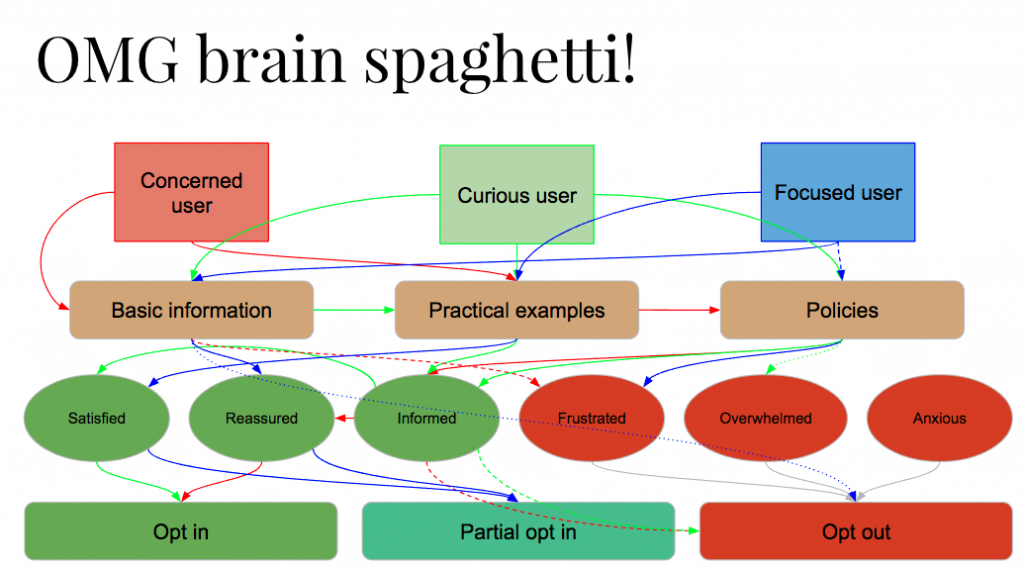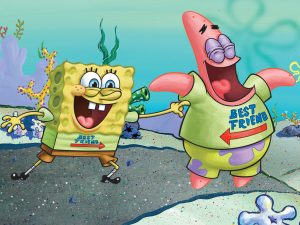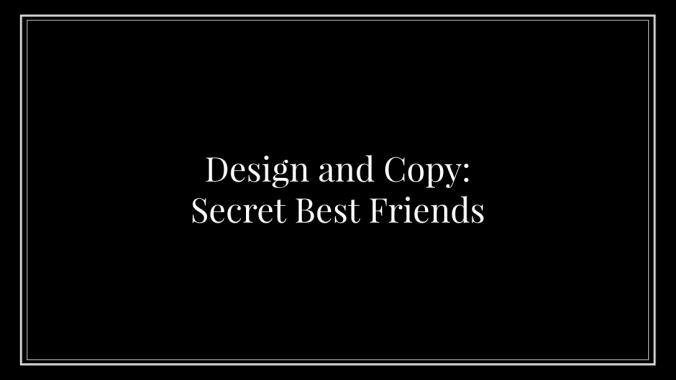Recently, as part of my job as a UX copywriter, I was asked to give a talk at a UX (User Experience) event that focused on impact. Since copywriting and UX don’t get paired all that often, I thought it was a great opportunity to share my thoughts about why they belong together.
My talk was really well received, and I’ve been asked about it by many friends and colleagues who weren’t at the event, so I thought I would share a version of it here (imagine the headings, pictures and quotes are slides and you’ll get the idea). And, if you have thoughts, please do share them in the comments.
Words give you feels
I want to begin by sharing a story about a story. Some of you will have heard it before. As legend has it, someone once challenged Ernest Hemingway to write a complete story using only six words. He came up with this:
For sale: baby shoes, never worn
– Ernest Hemingway
Six words, and you can see the entire thing, can’t you? Did it make you feel something? For those who didn’t feel anything: are you made of stone?! Let’s look at a couple more.
My dad thought condoms were uncomfortable.
– Rob Labelle
It’s funny, right? And a bit awkward. And then you think some more about it and it becomes poignant and maybe even painful.
I still make coffee for two.
– Author unknown
Speaking of pain. Again, just six words, but you can feel the loss and the loneliness seeping from them. There are 28 characters there, including spaces. But many of you have a picture in your head right now that goes way beyond. A picture may paint a thousand words, but imagine for a moment if every one of the thousand words were as carefully chosen as these, and had as much impact on your imagination.
Once upon a time . . .
Now, I’m going to tell you another story. This one is a story about me. Once upon a time, I was a tech writer. Or, as it stated on the business cards I never handed out because no one ever wants to meet that person, a documentation specialist.
Tech writing is dry
Creative writing is . . . wet? No, that’s not the right word!
Tech writing is a noble profession, and I don’t want to malign people who do it and love it – and they do exist. It’s needed, under-appreciated, and it takes special skills to do it well. But for me, as a full time job, it was unfulfilling and lonely.
I’m a creative writer at heart, and tech writing doesn’t lend itself to creativity. Also, to me, tech documentation always felt like the thing someone needs to write, but no one actually wants to read. Ever. Like car stereo instructions, reading documentation is usually a last resort. And I wanted to write things people wanted to read.
To give a little context, at that time I was working as a tech writer 80% of the time. I had one day off a week that I used to write my first novel. When that one was finished, I wrote another one, then a third one started to take shape, and so on. I’d written creative things before that, mind you, but there’s something about staking 20% of your salary on a thing that motivates you to really put your all into it. And I did, and I fell in love with writing again.
And as I worked more and more with the kind of writing I enjoyed, I became steadily more detached from my day job as a tech writer. When I was writing novels and short stories, I felt alive. The other four days a week, I felt like a worker bee, just doing a thing to get the money I needed to feed the “real” thing.
I’m sure that approach works for some people, but for me it was unsustainable. The creative part of me, once unleashed, wasn’t content with one lousy one day a week. But, like anyone, I had bills to pay and realities to face. I needed to find a compromise.
So, I quit that job and became a freelance editor and copywriter. I thought it would give me more flexibility to work on my “real” writing. (Spoiler: it didn’t.) But what it did do was send me along a path that helped me understand why it was so important to me that people wanted to read what I write. Sure, some of it is ego-driven, and I doubt there’s a creative writer alive who isn’t at least a little bit driven by that, but it was mostly because of the way I write.
Finding the right word, or combination of words, feels the way I imagine shaping clay must feel to a potter. I stare into space for longer than is comfortable for anyone to watch. I make faces. I roll words around on my tongue. I try this word or that word out of context and then back in context, and I listen to how it sounds. The end goal of all this weirdness is to find that perfect way of expressing an idea or image so that it will have just the right effect on the reader. That’s where the thrill is for me. The careful selection of words to elicit the emotion I want someone to experience.
Dance, little puppets, dance!

Does that make me manipulative? I don’t know. I took the Pottermore Hogwarts Sorting Hat test thing and I came up Slytherin, so yeah, maybe.
What is a copywriter?

Anyway. Traditionally, when people think of copywriting, they think of things like advertising copy, right? Don and Peggy. Taglines and slogans. Witty aphorisms that inspire you to trust or become loyal to a certain brand. Words that make you want to buy things. That’s the association people make. They don’t often think UX or design. But when you think about what advertising copy actually does for consumers, it becomes kind of obvious that UX is where writing for products naturally belongs. I mean, what are we doing with the text in our products if not providing a verbal experience for the user that sits comfortably and naturally alongside the visual design? It doesn’t take a great leap to realize that if words can compel people to buy things, they can also compel them to, say, click things.
UX Copywriting
Wait, is that a thing or did you just make it up?
In the past, the job of writing copy for products often fell to marketing people or even tech writers, just because they’re writers and they already exist as a thing. Anyway, how many ways can there possibly be to say “enter your phone number” right? How difficult can it be?
With that kind of thinking, and more often what happens in reality, the task of creating product strings and supporting copy falls to developers, who stick in some placeholder text because it’s needed and it says what the thing does, and maybe down the track, someone tweaks it or corrects it, and that’s what goes live. But lately, that attitude has begun to change. Just last year, Facebook and Google began advertising for “UX Writers” and “Resident Wordsmiths”.
And along the same vein, this is where SPT also made a really smart choice. They hired me! Hah! No, what I mean is, they made a smart choice when they decided to create a copywriting role within a UX team.
Narrative design
Shaping the product’s conversation
Why was that smart? Because UX copywriting is about more than just text. It’s about narrative design, and conversational design. When you want to create an interaction that feels human, you need to consider language and tone and formality, because humans use language in varied and subtly nuanced ways to connect with each other. If we want users to connect with our products, the product’s language needs to make their experience feel the same as their experiences of connecting with people.
Consider the way digital products are evolving: language is becoming an intrinsic and vital part of the interface. Think of Siri, Alexa, OK Google and so on – these are products that minimize visual interaction and replace it with an almost exclusively verbal interface. It’s not an accident that UX writing is becoming a real job title at the same time.
Now, I don’t know about any of you, but I’m not working on any AI-based conversational interface products at the moment. But what I am aware of is how these products, products that are designed to feel human, are shaping users’ ideas about how they interact with products in general. It’s becoming the expectation that the copy we use in digital products will be conversational in nature. It is no longer acceptable—or necessary—for digital products to sound, and therefore feel, like soulless robots.
This means a whole different kind of language is becoming more and more essential in our products, and it takes a special skillset to create that interaction.
Enter the creative writer!
I’ve been in this role for just over four months now, and my first job has been within the privacy team, and while privacy policies tend to elicit the deepest of oh-my-god-boring groans from most people, it’s actually a uniquely challenging area when it comes to copy.
Overcoming the groan
Privacy policies that don’t induce comas
The first challenge when introducing privacy policy information to users was to overcome that groan reflex. How can we give users information about their online privacy, our policies, the regulations, their rights, our responsibilities . . . see? Your eyes are closing! You’re falling asleep right now, aren’t you!
How can we get this information across without inducing a narcoleptic seizure? And if we succeed there, we then need to tell them we’re collecting data about them and using it to sell them stuff without them getting paranoid and deleting their account! And then, if we make it past boredom and fear, can we then also manage to interest them long enough to gain their trust? Maybe even spark a sense of curiosity and even delight?
The narrative journey
A rollercoaster of emotion . . . about privacy?
No way? Way.
All these topics, presented in a certain order, take users on a narrative journey through both the information we need to present, and the emotions they might experience as a result.
My approach to this was to first create a content strategy that involved identifying users’ potential state of mind before their interaction with us, the state of mind we wanted them to be in when they were done, and the one they might end up with if we got the information flow wrong. What I ended up with was this:

Yes, it looks like hell, but stay with me. Looking at all these potential pathways through the information, at different levels, helped me find ways to use words, alongside engaging design, to bring about education, trust and confidence before presenting users with the option to remove themselves from our data collection efforts – which of course we don’t want them to do.
Obviously this is different from the narrative flow of a novel or a movie. It’s actually closer to the narrative flow of a video game, in the sense that a user will look for ways to get the information and action they want and avoid anything that looks even remotely boring, like, for example, a privacy policy. The difference here, besides not actually being a game, is that both we and the user have an agenda, and those agendas are sometimes – or often – at odds.
So what it comes down to is that we need to guide people through an engaging experience that gives the right information at the right time, at the right depth to users with different motives and agendas, to end up with the desired effect: in this case, an educated user who trusts us to handle his or her private data responsibly and decides to stay opted in to data collection. And that is where a beautiful relationship comes into play.

Aww
By combining engaging visual design with simple, friendly language that gives information to users in a palatable way, while assuring them that there is a value proposition in place that offers them both benefits and control, we begin a narrative design that will make the user want to take in the next piece of information. And the next. Until we’ve created a complete narrative journey, complemented along the way by engaging visuals and easy-to-use controls, that gives users the information we need them to have to become educated users of our products. Once they have taken this journey, they can make an informed decision about whether to stay onboard with our products. And if we have sculpted the narrative right, the user will trust us, and will even want to stay opted in for data collection because they understand the benefits.

So much winning!
When we get the narrative journey right, it’s win-win. It’s a win for the user and a win for us as a business. But it’s also a quiet individual win for writers like me.
Writing is lonely work
UX writing is collaborative
Writing is usually lonely work. Even for introverts – which most writers are – it can be all too isolating.
But in the UX environment, writing sits so closely alongside the design to create an experience that it can’t avoid being a collaborative process. For me, joining the Common Components UX team has killed two birds with one stone:

It has allowed me to be both social and creative in my day job so I can continue to manipulate take people on emotional journeys with words, and it has placed real value on that journey, making narrative design an integral part of the experiences we want our users to have.






Leave a Reply